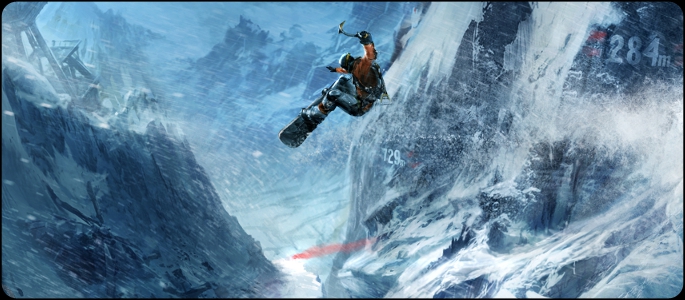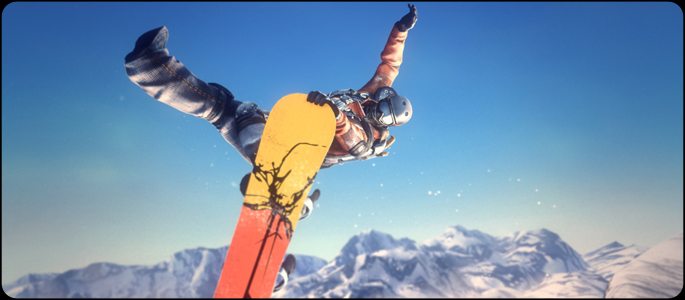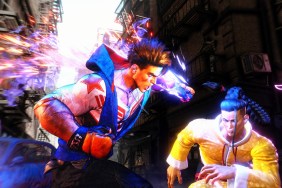Ah, SSX. It sure has been a long time since we’ve seen this series on any console – just a bit over six years since SSX On Tour graced the PlayStation 2 and Portable systems. While seemingly every other sport has made its current-gen debut, snowboarding has been sorely underrepresented so far. We’ve only really seen Shaun White Snowboarding, a game that was disappointing to say the least. Now that SSX is finally here, does the series’ new direction do it justice, or should we have kept Elise, Zoe, Moby and friends in the past? Read our review to find out.
The first thing you’ll notice when you reach the title screen of SSX is the lack of a traditional multiplayer mode. This is easily the game’s most glaring omission. There is no splitscreen option. That makes this entry the first console SSX without even local multiplayer. But all hope for interaction with other gamers isn’t lost, thanks to the introduction of EA’s “RiderNet” social network. Similar to Need for Speed: Hot Pursuit‘s Autolog feature, you can see who on your friends list is doing what in the game. You can play against their ghost data in an attempt to one-up them, as well as leave GeoTags earned throughout the game. These geotags earn you in-game credits for as long as they are not found by another player. So you can get pretty creative as to where you place these to receive the biggest bonuses. SSX does come with an online pass, but as expected it only blocks out access to your earned credits while playing online. You can still access every part of the game, including the “Global Events” which reward you various tiers of credits based on your performance. You can create custom events, but none of it is in realtime. Without that key aspect to the multiplayer, it all feels just slightly lacking.
With that big gripe out of the way, what’s left of SSX is mostly a smooth ride. The mountains you get to ride down are immense, meticulously crafted, powdery heaven. There are a seemingly endless amount of routes which you can take on any given run, each with their own advantages and disadvantages depending on what event type you are participating in. You have your typical races, trick events, and ghost runs against the main antagonist Griff (more on that in a minute), as well as what are essentially boss levels in the form of “Deadly Descents,” which up until recently was this game’s subtitle. Each of the nine mountain ranges you conquer include one of these descents, and they each focus on an aspect of extreme snowboarding that can be potentially lethal: Gravity, avalanches, extreme cold, thin air to name a few. These descents introduces a new type of equipment to combat the hazards, such as ice picks to help you carve quicker, oxygen masks to help you breathe on Mount Everest, etc. While it may sound gimmicky to some of you, the execution is such that for the most part these tools add to the intensity of the descent, and if you fail too many times you are at least given the chance to skip it.

Audio work here is decent, with a pumping soundtrack including the Run-D.M.C. song “It’s Tricky.” You can also use your own soundtrack, which are subjected to the same sound effects as the main tracks when you have a nice combo going or get some big air. Sound effects are what you’d expect, though the deadly descents usually have a little something extra, such as a howling wind, the crackling as you freeze, or muffled sounds the closer you are to blacking out. DJ Atomika makes a voiceover appearance as well, and he narrates team SSX‘s progress against their rival Griff. You see, Griff defected from team SSX (which now stands for Snowboard, Surf, Motocross representing the team members’ diverse extreme backgrounds), and he is now attempting to conquer all nine deadly descents before an entire team of nine athletes does the same. The narrative is pretty barebones, but then again who ever plays a sports game for the story? Each of the characters on Team SSX must first be beaten in a race, and they are then introduced via a comic book-style video. Speaking of video, the graphics in SSX are smooth, with little effects thrown in when you complete a nice combo or are hot on somebody’s trail. The framerate stays pretty consistent throughout, and the wave-like effect when slamming down in Super Tricky mode has been toned down a bit compared to what we saw at E3.
SSX includes a brand-new control scheme, not too far removed from the game-changing skate series. You use the right analog stick to direct which hands do what trick to your board. Veterans of the series can also opt to use the face buttons and play the game just like they remember it. Once you get a nice enough combo going, you enter “Tricky” mode, which unlocks a subset of moves until your combo runs out. Beyond that there is also “Super Tricky,” which unlocks an “Über move” worth a kajillion points if executed correctly. Playing with both analog sticks to perform tricks feels pretty natural, and in no time at all you’ll be tricking like a pro. However, the system is pretty hard to master, and that becomes painfully obvious in the later stages of the singleplayer game. The AI is pretty much flawless in their runs, especially in races. Winning requires familiarity with the run, which just isn’t something you can expect the first couple of times down. I suppose this is the case any time you play a new game, but to have your ass so readily handed to it in later stages is disheartening. Luckily, you are given the option to skip a run after a few failures, saving you the frustration of having your progress grind to a halt because you just can’t get past one run. Some people may see this as taking the easy way out, but it is a nice gesture from the developers who realize not everyone cares about completing a game 100%.
With an impressive set of levels based on real-world topographical data provided by NASA, hundreds of connected events to conquer, and the always-on RiderNet to tie scores together, there is a ton of content in SSX. More importantly than that, controls are tight and incredible combos can be linked together by all the seasoned players out there. Yet there is plenty here for beginners or new players of the series. The lack of realtime multiplayer, splitscreen or otherwise, definitely holds back SSX from greatness. For fans of SSX and snowboarding, this is an easy recommendation. The difficulty can be brutal in later stages, but thanks to a handy skip feature you can see all the single player campaign has to offer without much of a headache. Normally I’d say “see you on the slopes,” but given the game’s multiplayer I’m going to leave you with a “see your ghost on the slopes!”
PlayStation LifeStyle’s Final Score
+ Intense riding, highly-integrated “RiderNet” online social network. – No realtime multiplayer, difficulty ramps up too quickly towards the end. |
 |








